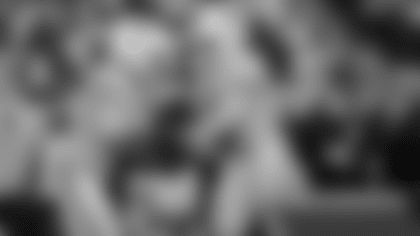*
Each week during the offseason, Senior Writer/Editor Scott Smith will dip into the inbox to answer questions from Buccaneer fans. The NFL calendar is at its least active part in the lull before training camp, so a slim mailbag means we have just two topics of discussion this week. Therefore, we're diving deep on those two subjects: touchdown efficiency goal in the red zone and the basis for the optimism surrounding the Bucs' 2017 campaign.*
Fans can submit questions for upcoming mailbags via Twitter to @ScottSBucs (#BucsMailbag), through a message on the Buccaneers Official Facebook Page or via email at **tbbsocial@buccaneers.nfl.com*. The One Buc Mailbag runs every Thursday and is not necessarily meant to reflect the opinions of the team's management or coaching staff.
*1. Scott- Back when the Bucs were practicing, before they were on this break their on right now, you tweeted about coach Koetter saying he wanted the offense to get up to 60 percent in the red zone this year. I don't know how to put a whole tweet into an email but I'm looking at it again now and you said…."Dirk Koetter says the Bucs are raising their red zone goal this year to scoring touchdowns on 60% of possessions." I've been wanting to write in and ask if that would be a really high number, like in terms of the NFL as a whole and how the Bucs have done in the past. 60 percent doesn't seem all that high to me but I don't know what past numbers have been like and I don't know where to look it up. I'm hoping you answer my email because training camp and the season still seem like far away and I need some kind of Buccaneer fix right now while nothing is going on. Thanks! A Buc Fanatic in Jaguar Land (named Allen Wright, if you need a name to put in your column) (via email to
Allen added the first parenthetical remark, I added the second. He must have seen previous Mailbags in which I was trying to figure out the name of an unidentified question submitter through his or her email address. Thanks for saving me the trouble, Allen!
So, yeah, here's that tweet from June 14, which was during the team's offseason-capping mini-camp.
This was Koetter's full quote, which came in response to a question about Jameis Winston potentially having a greater number of dangerous red-zone targets this year:
"We have good options. We were actually, I think, about 51 percent touchdowns in the red zone. The league took a jump – it used to be that 55 percent touchdowns would put you in the top five in the league. Tennessee led the league at 72 percent. That's insane – 72 percent touchdowns. There were, I think, four other teams over 60 percent. We've actually raised our goal this year to try to be 60 percent touchdowns; that's something we have to do better. We haven't necessarily done better the last two days, but it's a process, like everything else."
And here's the one response I got from that tweet, which I actually find kind of cryptic:
Not sure what Martain means by "It would soon return to a manageable target." That 60% is not a realistic goal and aiming for it is a fireable offense? Is the first part of that true? Let's see. You wanted numbers, Allen. You're going to get numbers. (If you crosscheck what's below with Koetter's quote above, you will see that the coach has a very good grasp on how the league as a whole fared in the red zone last year. He had no idea this particular question was coming but he was able to give an accurate picture of the situation as a whole. If anything, Koetter undersold how good the league was in the red zone last year.)
Tennessee did indeed lead the league by scoring touchdowns on 72.0% of their red zone trips in 2016. That's a very high number, though not unprecedented. Oakland put up a 72.4% red zone TD efficiency in 2014, and Denver had a whopping 76.1% mark in 2013. I have easy access to red zone numbers back through the 1995 season, and the Titans are the 12th team in that 22-year span to finish about 70%. The high-water mark in that time was 77.8% by Kansas City in 2003. That stat does seem to have a good correlation with winning; six of those 12 teams won double-digit games and together they averaged more than nine wins a season. The real outlier was a 1999 Cleveland team that finished 2-14 despite scoring TDs on 71.4% of their red zone drives. (The problem: The Browns had a league-low 28 drives that managed to reach the red zone.)
After the Titans, there were 10 other teams that surpassed the 60% mark last year, and the overall league average was 55.6%. Playoff teams averaged 59.9%. The Buccaneers ranked 21st with a red zone touchdown efficiency of 51.9%.
So, how does 55.6% rank as a league-wide red zone average? Take a wild guess.
Over that same 22-season span for which I have easily-available red zone data, the 2016 season represented the league's second-best overall red zone efficiency. The top mark was posted the year before, in 2015, at 56.2%. Like everything else offense-related in the NFL, those numbers have been increasing steadily over the last couple decades. From 1995-2001, every season finished with a red zone efficiency between 48.0% and 51.7%, only twice crossing 50%. From 2002-11, every season was in the 50.8-53.9% range, only once going over 53%. From 2012-16, the range increased from 53.5-56.2%, only once falling under 54%. So Koetter's clear belief that the Buccaneers need to up their target red zone percentage in order to keep up with the NFL Joneses is well-founded.
If the Bucs can hit 60% or better, they'll set a new team high (since 1995, at least). Their best mark in that span came just a few years back, when they scored touchdowns on 59.6% of their red zone trips in 2012. That was significantly better than the league average of 54.1% that season. The Bucs were better than the league average in the red zone in six of those 22 seasons; their best performance in relation to the average was in 2000, when the league scored TDs at a 49.8% clip but the Bucs did so at a 57.4% rate. Tampa Bay's worst red zone season in relation to the league average was just the year prior to that, however, as the NFL was good for 48.0% but the Bucs dipped all the way 33.3%.
Again, 11 teams topped 60% last year, so it's far from an unreasonable goal. It's also an important goal. One more win would have had the Buccaneers in the playoffs last year. Given how many games are decided by slim margins, one more red zone touchdown instead of a field goal attempt could make all the difference in the long run.
2. Enemy Lines
I feel pretty confident that Wayne did not expect an answer to this question. The avatar and the "BirdGang" in his handle make it obvious that he's a Falcons fan, and one not expecting much of a challenge from the Buccaneers this year.
Considering that perspective, it's not an unreasonable question. He directed it at me and the Bucs' twitter account, which are admittedly biased sources to some degree. (He also directed it at the Raymond James Stadium account, so…um, I guess he told them?) As MMQB's Greg Bishop noted earlier this week, this is the NFL's "Optimism Season," and there's probably a stronger whiff of that in the Bay area than some other NFL outposts. I was asked by a crew from the Giants last week about the mood around the team this season, and I told them this felt like the most confident Buccaneer group heading into an offseason since 2011. That team had a young and promising quarterback and was coming off a 10-6 season in which it only missed the playoffs on a third-level tiebreaker. Sound familiar?
That comparison would certainly feed into Wayne's point of view. The 2011 season did not go well (4-12), the young quarterback (Josh Freeman) was gone less than two years later and there was a new coaching staff in place by 2012. In retrospect, the optimism during the Bucs' 2011 offseason – after their "Race to 10" the year before – was not completely warranted. Are we going through that same cycle again during the 2017 "Optimism Season."
BirdGangWayne obviously feels so, and he's surely brimming with the hubris of being a fan of the defending NFC Champs. But I'm going to disagree. I don't think 2017 is directly comparable to 2011, despite those superficial descriptions of a barely-missed playoff shot and a young quarterback. I believe I'm writing with as little bias as possible (it's not completely avoidable) when I reject the notion that the team and I are selling "false hope" to Buccaneer fans.
Let's start with the quarterbacks. I think it's fair to say that Jameis Winston has already proved to be a more charismatic leader than Freeman, his predecessor as a Buccaneer first-round quarterback. Freeman, the 17th overall pick in 2009, started nine games as a rookie and had 5,306 yards, 35 touchdowns and 24 interceptions through his first two NFL campaigns. He did indeed have a very promising 2010 season, with a 95.9 passer rating that was built largely on a 25-6 TD-INT ratio that proved unsustainable. Winston, the first-overall pick in 2015) has started every game and taken nearly every snap in his first two seasons. He already has 8,132 passing yards, 50 touchdowns and 33 interceptions. That last number needs improvement, obviously, but in addition to his great leadership skills Winston is already almost legendary for how hard he works at perfecting his craft.
Beyond the quarterbacks, the current roster is simply deeper and more talented. Much of that can be traced to improved draft results. The Bucs thought they had a keeper at first with Freeman, and they made astute first-round picks in 2006 (Davin Joseph), 2008 (Aqib Talib) and 2010 (Gerald McCoy). There were a few other draft hits from 2006-10, including Tanard Jackson, Jeremy Zuttah and Mike Williams. But there were a whole lot of misses, too: Alan Zemaitis, Gaines Adams, Arron Sears, Sabby Piscitelli, Dexter Jackson (the receiver, not the safety), Kyle Moore, Brian Price, Myron Lewis, Arrelious Benn, etc. A lot of those were high picks, too. That many misses in the draft makes it hard to build a deep roster, and there weren't any notable free agency home runs in that span to make up for it.
Now check out some of the players the Buccaneers have drafted since 2014: Mike Evans, Charles Sims, Kevin Pamphile, Jameis Winston, Donovan Smith, Ali Marpet, Kwon Alexander, Vernon Hargreaves, Noah Spence. I believe O.J. Howard, Justin Evans and Chris Godwin will be strong additions to that list, but it's probably not fair to count them until they've actually played in the NFL. The jury is still out on kicker Roberto Aguayo, but the only notable misstep in the early rounds otherwise in that span is Austin Seferian-Jenkins.
The Bucs' free agency efforts early in that span (2014-17) didn't go well, but last year brought in Bryan Anger, Robert Ayers, Brent Grimes, Josh Robinson and J.R. Sweezy. Sweezy didn't play last year but looks like he'll start in 2017. Add to that the 2017 free agency haul of DeSean Jackson and Chris Baker and this is a team with fewer obvious depth chart issues than any recent Buccaneer roster. Some of that is still optimistic thinking – it's certainly possible that Jackson, Baker and Howard won't be as valuable of additions as the Buccaneers believe they will be. It's hope, yes, but I don't think it's false hope.
Furthermore, this is a team that is trending in the right direction. The Buccaneers were 2-14 in 2014 before improving to 6-10 in 2015 and 9-7 last year. Since the 1970 AFL-NFL merger, there have been 14 teams (not including the current Bucs) who improved by at least two wins in two consecutive years but did not make the playoffs in that span. Six of those 14 teams made the playoffs the following year (what would be 2017 for the Buccaneers); eight of the 14 won at least as many as not more games as the year before.
The most recent example of that trend: Wayne's own Atlanta Falcons. The 2013 Falcons were 4-12 before improving to 6-10 in 2014 and then to 8-8 in 2015. We all know what happened last year, when the Falcons were in an equivalent position to where the Bucs are right now. Furthermore, the Falcons got a new coaching staff between the second and third of those seasons…exactly like the Buccaneers.
That's an encouraging trend. Here's another one: Tampa Bay's defense, which got a new coordinator in 2016 in the person of former Falcons Head Coach Mike Smith, made a stunning turnaround at the midpoint of last season. During the first eight games, Buccaneer defenders struggled to master Smith's schemes and to communicate effectively with each other. As those issues started to become resolved around midseason, Tampa Bay's defense went on a tear. Over the final eight games of 2016, the Buccaneers ranked fourth in points allowed, second in opponent passer rating allowed, tied for fifth in sacks and first in turnovers.
And who have the Bucs lost from that group. Bradley McDougald, a starting safety. There's a very good chance that either free agent acquisition J.J. Wilcox or second-round draft pick Justin Evans will be able to replace McDougald's 92 tackles and two interceptions from a year ago. Otherwise, the only departures from that group are strongside linebacker Daryl Smith, who did not have an enormous impact in 2016, and reserve defensive tackle Akeem Smith. The addition of Chris Baker in free agency likely is an upgrade at the DT position, so that linebacker spot is probably the least certain part of the Bucs' defensive transition from 2016 to 2017.
The Buccaneers' biggest and most obvious deficiency on offense was a lack of speed and, relatedly, big plays in the passing game. The team could hardly have addressed that issue more directly than by bringing in DeSean Jackson, and then the draft delivered Howard and Godwin. National NFL pundits seem to agree with the Buccaneers' belief that those additions will make Jameis Winston a much more productive quarterback, particularly in terms of getting the ball downfield.
Okay, I've just spent about 1,300 words rebutting a fairly innocuous bit of intra-division trash-talking on Twitter. If that was a troll job by Wayne, it worked to perfection. Even so, I still think it's worthwhile to disagree with that idea of "false hope." It's very unlikely that the Buccaneers will be exactly as good in 2017 as they were in 2016. That means the team will either get better or worse this year. Despite all the optimism in the Bay area, it wouldn't be the most shocking outcome of all time if the Bucs got worse in 2017. Yes, it could happen. But if you have to argue one side or the other, I honestly don't see how you can look at how the 2016 season finished and what the team has done since and choose to argue for worse. And if the Bucs get even just a little bit better, they should be back in the playoffs for the first time in decade. There's definitely a very real – not false – hope in Buccaneer-land that this will happen.
(The other option here was to talk trash back, but I honestly believe the Falcons are going to be very good again this year. I'm not seeing a Super Bowl hangover here.)



































